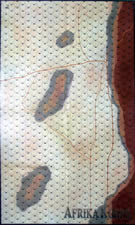|
Night Raid DAK '44 #4 |
||
|---|---|---|
| (Attacker) Germany | vs |
Britain
(Defender)
Gurkha (Defender) India (Defender) |
| Formations Involved | ||
|---|---|---|
| Britain |  |
50th Reconnaissance Battalion |
| Germany |  |
5th Light Panzer Division |
| Gurkha |  |
2/4th Gurkha Rifles |

| Total | |
|---|---|
| Side 1 | 0 |
| Draw | 0 |
| Side 2 | 2 |
| Overall Rating, 2 votes |
|---|
|
3.5
|
| Scenario Rank: --- of 913 |
| Parent Game | DAK '44 |
|---|---|
| Historicity | Alt-History |
| Date | 1944-04-01 |
| Start Time | 01:00 |
| Turn Count | 16 |
| Visibility | Night |
| Counters | 53 |
| Net Morale | 0 |
| Net Initiative | 1 |
| Maps | 1: AK2 |
| Layout Dimensions | 58 x 44 cm 23 x 17 in |
| Play Bounty | 156 |
| AAR Bounty | 171 |
| Total Plays | 2 |
| Total AARs | 1 |
| Battle Types |
|---|
| Ambush |
| Exit the Battle Area |
| Conditions |
|---|
| Terrain Mods |
| Scenario Requirements & Playability | |
|---|---|
| Afrika Korps | Maps + Counters |
| Cassino '44 | Counters |
| DAK '44 | Base Game |
| Introduction |
|---|
|
Better weapons would not have changed the confused nature of desert warfare. Particularly when waged at night. With the British advance blunted by the German counterattack, German heavy tanks begin massing for a counteroffensive. Elite Commonwealth forces infiltrate German lines under cover of darkness and attack a German armored column heading for the front. |
| Conclusion |
|---|
|
Tiger tanks would go to Tunisia in 1943, and they certainly would have been highly desired by an Afrika Korps still fighting in Libya in 1944. Their speed made them unlikely to pursue a fleeing enemy, but they could not be approached across the open desert without their opponents suffering severe losses. Unless they could catch them at night. |
| AFV Rules Pertaining to this Scenario's Order of Battle |
|---|
|
| 4 Errata Items | |
|---|---|

|
All Bren carriers should have a movement value of 7. (Shad
on 2010 Dec 15)
|

|
The reduced direct fire value of the Heer HMG became 5-5 starting with Fall of France. (plloyd1010
on 2015 Jul 31)
|

|
All SPW 251s have an armor value of 0. (Shad
on 2010 Dec 15)
|

|
Liberation 1944's Tiger movement and armor ratings are backwards. They should be Armor 7 and Movement 5. (petermc
on 2014 Feb 14)
|
| Tigres de noche | ||||||||||||
|---|---|---|---|---|---|---|---|---|---|---|---|---|
En este escenario imaginario, dos compañías de granaderos alemanes, sus correspondientes transportes SPW 251 y seis pelotones de Tiger y Tiger II entran por el lado oriental, deben avanzar por una carretera en el desierto y salir por el oeste. Una fuerza de la Commonwealth, compuesta por tres compañías de los temibles "gurkhas" y algunos pelotones de "Stag" (armored cars) y transportes "Bren", deben impedirlo. La batalla tiene lugar completamente de noche (visibilidad un hex), lo que da una ventaja especial a los "gurkhas", ya que se benefician de un modificador de + 2 en los asaltos. Dada la escasa velocidad de los Tiger alemanes y la corta duración del escenario (16 turnos), los vehículos alemanes deben avanzar por la carretera que cruza el campo de batalla en sentido este-oeste. Los "gurkhas" sitúan varias posiciones de bloqueo en la carretera (roadblocks) para impedir el paso. El primer choque se produce cuando los primeros SPW 251 y tanques alemanes llegan al primer bloqueo de carretera. Se libra una batalla muy intensa, con grandes bajas por ambas partes. Al final los alemanes consiguen despejar el primer bloqueo y se dirigen al segundo, donde de nuevo los Tigers son frenados por una compañía de gurkhas. Paralelamente, los "Stag" británicos se dedican a hostigar los flancos del avance alemán, especialmente las unidades de granaderos aisladas y los SPW 251, que son destruidos en su totalidad. El segundo bloqueo de carretera de los "gurkhas" está a punto de ceder, pero el tiempo se acaba para los alemanes, que no consiguen hacer salir del campo de batalla ni una sóla unidad. VP: Alemania, 16; Commonwealth, 26. Victoria menor de la Commonwealth. |
||||||||||||
| 0 Comments |

 Dk44003
Dk44003 



















